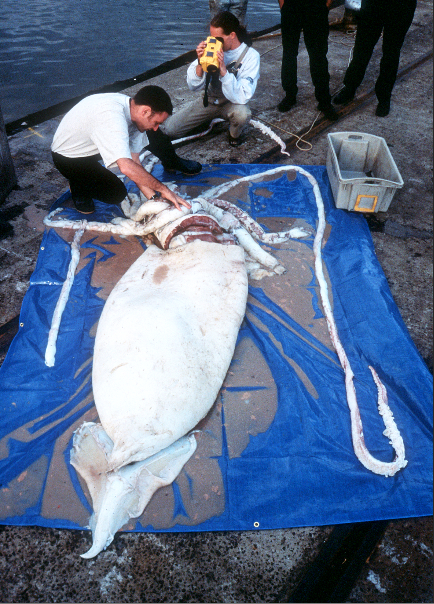Untangling the Mysterious Genetic Tentacles of the Giant Squid
Contrary to prior speculation about the elusive creatures, all giant squid belong to a single species and they all share very similar genetics
A model of a giant squid versus sperm whale. Photo taken at the American Museum of Natural History by Mike Goren from New York
For centuries, monsters of the deep sea captivated the imagination of the public and terrified explorers–none more so than the many-tentacled kraken. In 13th century Icelandic sagas, the Vikings wrote of a terrifying monster that “swallows both men and ships and whales and everything that it can reach.” Eighteenth century accounts from Europe describe arms emerging from the ocean that could pull down the mightiest ships, attached to bodies the size of floating islands.
Today, we’re fairly confident that a tentacled beast will not emerge from the depths to swallow up a cruise ship, but the enduring allure of such creatures lingers. None of the ocean’s massive animals, perhaps, are as intriguing as the giant squid.
Now, scientists have come one step closer to unraveling the mysteries behind this rare animal. As it turns out, contrary to some squid enthusiasts’ former hypothesis, all giant squid belong to a single species. What’s more, those animals are extremely similar genetically.
To arrive at these findings, researchers from the University of Copenhagen’s Natural History Museum of Denmark along with collaborators from 7 other countries genetically analyzed bits and pieces of 43 of the animals–which can grow more than 40 feet long and weigh nearly 2,000 pounds–recovered from all over the world.

Photo by Winkelmann et. al.
Their results indicated that, unlike most marine animals, giant squid harbor almost no genetic diversity. Remarkably, individuals as far apart as Florida and Japan, from a statistical standpoint, shared almost the same DNA. The giant squid’s genetic diversity turned out to be 44 times lower than the Humboldt squid, another large species, and seven times lower than the diversity of a population of oval squids living in a restricted area and thus prone to inbreeding. In fact, the giant squid’s diversity was lower than all other measured oceanic species, save the basking shark, which scientists believe recently underwent a severe population bottleneck in which most animals died and only a few individuals survived and repopulated the species.
The researchers can only speculate about this finding’s underlying reasons–the giant squid’s genetic data alone cannot provide a plausible explanation. Perhaps something about the giant squid makes it advantageous to cull mutations from its genome? Alternatively, the animals may have undergone a recent bottleneck, similar to what happened to the basking sharks, meaning that all giant squid following that event are closely related. Or perhaps a few foundered squid somehow wandered in new stretches of ocean, so when they populated these new habitats their offspring shared the same squid family tree. The short answer, however, is that the researchers simply do not know.
“We cannot offer a satisfactory explanation for the low diversity, and this requires future studies to resolve,” they write in a paper published this week in Proceedings of the Royal Society B.
This has been a big year for giant squid. In January, a Japanese team released the first footage of a giant squid interacting in its natural environment. Yet much still remains to be learned about these enigmatic creatures. For example, researchers still have no idea how large of a range the adult squid patrol, how long they live, how quickly they grow and whether problems such as climate change affect their populations.
For the imagination’s sake, however, perhaps it’s best if some mysteries endure.
“Despite our findings, I have no doubt that these myths and legends will continue to get today’s children to open their eyes up–so they will be just as big as the real giant squid is equipped with to navigate the depths,” said lead researcher Tom Gilbert in a statement.
/https://tf-cmsv2-smithsonianmag-media.s3.amazonaws.com/accounts/headshot/Rachel-Nuwer-240.jpg)

/https://tf-cmsv2-smithsonianmag-media.s3.amazonaws.com/accounts/headshot/Rachel-Nuwer-240.jpg)